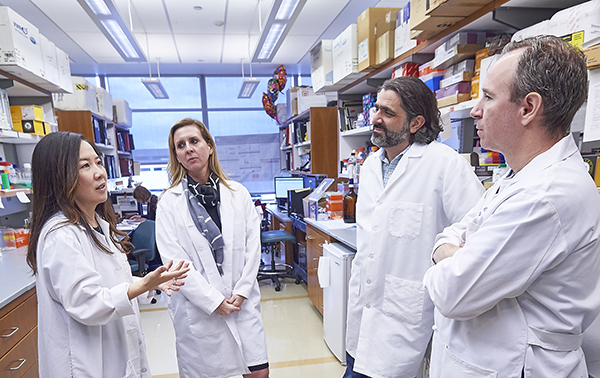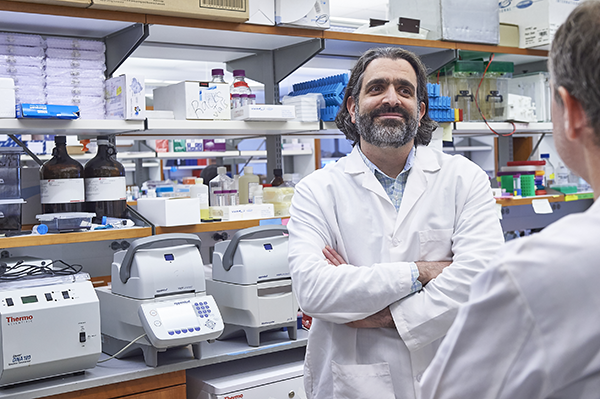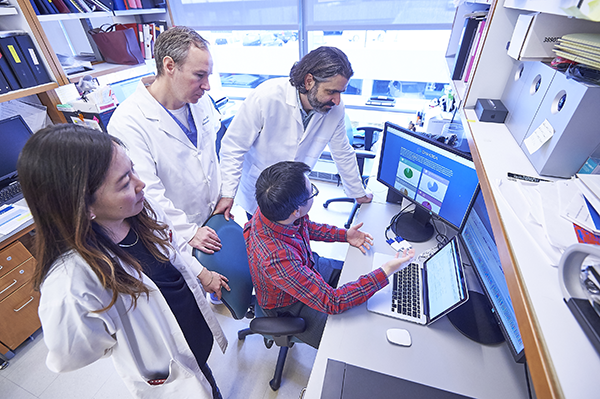HOW CAN WE HELP YOU? Call 1-800-TRY-CHOP
In This Section
CHOP Leads Big Data Collaboration to Uncover Pathways Between Cancer and Birth Defects
 When most of us think about cancer, a number of factors — from smoking, to sun exposure, to specific organs where a disorder develops — might jump to mind. But for Adam Resnick, PhD, co-founder of the Center for Data Driven Discovery and Biomedicine (D3B) at CHOP, in order to unravel the inextricable link between childhood cancer and other rare conditions, we must visualize pediatric cancer as a process.
When most of us think about cancer, a number of factors — from smoking, to sun exposure, to specific organs where a disorder develops — might jump to mind. But for Adam Resnick, PhD, co-founder of the Center for Data Driven Discovery and Biomedicine (D3B) at CHOP, in order to unravel the inextricable link between childhood cancer and other rare conditions, we must visualize pediatric cancer as a process.
As a single-cell zygote proliferates into a 37 trillion-cell being, something happens in the course of its development — a dysfunction, a deviance, a DNA-driven decision — that underpins not just the development of life-changing birth defects, but a potential vulnerability to childhood cancer as well.
Deconstructing this shared biology seemed nearly impossible for rare disease researchers only a decade or two ago. Today, a unique and pioneering endeavor funded by the National Institutes of Health (NIH) Common Fund and fueled by technology will give investigators a powerful tool for piecing together the science behind Dr. Resnick’s visualization: data — and volumes of it.
The Gabriella Miller Kids First Data Resource Center (Kids First DRC) is a multi-institute collaboration that aims to advance our knowledge of cancer and birth defects through large-scale sharing of genomic information. Investigators, clinicians, data scientists, and patients will work together to build the Kids First DRC’s chief outward-facing tool: a centralized, cloud-based database and discovery portal containing well-curated clinical and genetic sequence data.
The portal operates in a simple but synergistic fashion. Patients and their family members will act as partners in agreeing to enter their data into the portal. The information will be integrated with tens of thousands of sequenced bio-samples collected from blood, DNA, tissue, and saliva to determine if mutations or genetic changes exist for each disease type. Users across the world can then access the genetic disease data at one central location and share their findings or collaborate in real time.
For Jesse Taylor, MD, attending surgeon in the Division of Plastic and Reconstructive Surgery at CHOP and a co-investigator of the Kids First DRC, the portal is a harbinger not just of a new era in discovery; it also provides a precision approach to help treat patients based on the specific characteristics of their disease.
“The ultimate goal is to cure craniosynostosis, cleft lip and palate — to cure these problems that I see over and over every day,” Dr. Taylor said. “That really will have a very profound effect on families. This is the most exciting thing I’ve ever been involved in my whole life. The opportunity to cure problems that affect thousands of kids every year is awesome.”
Integrating Cross-disease Analysis
The Kids First DRC combines efforts between CHOP, the Ontario Institute for Cancer Research, the University of Chicago, Children’s National Health System, the Oregon Health and Science University, and Seven Bridges. It constitutes a part of the broader Gabriella Miller Kids First Pediatric Research Program, launched in 2015 by the NIH Common Fund to help researchers better understand the role of genetics in childhood cancer and structural birth defects, and the genetic pathways underlying these conditions.
 Also, the Kids First DRC is the main project of a partnership within CHOP between the Craniofacial Program and the D3B, the latter of which is currently co-directed by Dr. Resnick and Phillip “Jay” Storm, MD, co-founder of the D3B, along with Angela Waanders, MD, MPH, as director of Clinical Research, and Jena Lilly, MS, as director of Operations and Strategic Planning.
Also, the Kids First DRC is the main project of a partnership within CHOP between the Craniofacial Program and the D3B, the latter of which is currently co-directed by Dr. Resnick and Phillip “Jay” Storm, MD, co-founder of the D3B, along with Angela Waanders, MD, MPH, as director of Clinical Research, and Jena Lilly, MS, as director of Operations and Strategic Planning.
“For the first time, the Kids First Data Resource Center is trying to integrate cross-disease analysis in pediatrics in a way that has never been approached historically,” said Dr. Resnick, who acts as principal investigator of the Kids First DRC.
Though statistics show that children with a cleft palate or birth defect of the central nervous system are two to four times more likely to have a cancer, scientists have yet to understand the potential pathways underlying both conditions.
“A lot of childhood diseases that people are born with are some sort of failure of genetic programs in utero — when you’re in your mother’s belly,” Dr. Taylor said. “And it’s interesting that a lot of pediatric tumors share common genetic pathways with cleft and craniofacial anomalies. By learning more about brain tumors, we may help ourselves learn more about other congenital anomalies. And by learning about the congenital anomalies like craniosynostosis, we may learn more about how to treat brain tumors.”
Power in Numbers: Genomic Data on the Cloud
In the last few years, drops in the cost of generating data and advances in cloud-computing technology have made sequencing large cohorts of information a powerful possibility. Platforms like CAVATICA, an open-access pediatric genomic data cloud and NIH Trusted Partner developed by Seven Bridges in 2015 and also co-led by Dr. Resnick, have shown how data science and medicine fuse to drive discovery.
Like CAVATICA, the Kids First DRC will allow investigators to securely perform complex analyses of massive amounts of data in real time. It will allow portal users to view, analyze, visualize, and share data within one location.
By the end of 2018, Dr. Resnick expects the database to contain 25,000 whole genomes collected by rare disease experts. If we liken a person’s entire genomic code to information contained on a CD, he explained, the Kids First DRC portal will contain hundreds of CD’s and DVD’s of data that continues to multiply.
Meanwhile, Dr. Taylor likens the project to another technological advance: “It’s the same type of theoretical advantage that exists with social media, where you have massive amounts of data being shared amongst a large group of people. Thus, the greater the chance of somebody figuring out certain pathways.”
Bringing Scientific Specialties Together
The uniqueness of the Kids First DRC goes beyond its use of savvy software and embodies a “shared domain” in yet another sense of the term. Working toward the shared goal of advancing cancer and birth defect research, the outward-facing portal will be built and accessed by scientists and clinicians across different specialties as well as by patients, families, and foundations.
Up until now, researchers and clinicians have, for the most part, been grouped by and focused on their specialty — whether it be the lungs, bones, heart, brain, or other organ system in the body. These experts examine patients, collect data or samples, and gain knowledge within their respective domains. For the first time, the Kids First DRC gives investigators a tool to not only share the rare collections of specimens that they have spent their careers amassing, but access data from conditions outside of their specialties as well. The portal will convert disease data into a standard format, giving researchers the ability to compare different diseases at a genetic level and, potentially, discover shared genetic architectures underlying different conditions.
 For example, the fields of birth defects and childhood cancer historically have never really come together, Dr. Resnick explained. “Structural birth defects are focused by domain experts within their specific organ of interest, while pediatric cancer was often tied with adult cancer but not fully embraced in a way that supported their biological underpinnings and development.”
For example, the fields of birth defects and childhood cancer historically have never really come together, Dr. Resnick explained. “Structural birth defects are focused by domain experts within their specific organ of interest, while pediatric cancer was often tied with adult cancer but not fully embraced in a way that supported their biological underpinnings and development.”
As one of the hundreds of clinician-investigators involved in the Kids First DRC, Dr. Taylor looks forward to both contributing and conducting research through the portal and broader Kids First program.
“The way I see myself involved in Kids First is as part of the same tank that’s going to come up with research questions and ways to explore those questions,” Dr. Taylor said. “And then my hope is that I’ll be someone who provides the most tissue for those efforts but also someone who can draw in other centers to participate.”
Patients as Partners
Patients, families, and patient advocacy foundations make up another unique and important part of the Kids First DRC. At a November Patient and User Foundation workshop hosted at CHOP on behalf of the Kids First DRC, Dr. Resnick described patient foundations and families as the “tissue” binding the portal together. These individuals, who provide funding, support, and awareness, create a solid “body” around what Dr. Resnick describes as investigations and data sets that would, otherwise, simply sit beside each other like cells and organs in the body.
“Our job in the data resource center is to present this data to the rest of the world, empower it for discovery, engage collaboration among investigators who often times have never even heard of each other, support the capacity to look across diseases, harmonize across this data — but all of that will fail if we don’t bring you into the picture,” Dr. Resnick told the audience. “The portals and the information have to go beyond just the number of investigators.”
During the workshop, individuals from a variety of organizations that support pediatric research offered their input and guidance about how to best design the portal for effectiveness, accessibility, and usefulness. This is critical, since patients and foundations will use the portal as a community resource to learn about their disease, and find support groups and other disease-related resources.
“People actually haven’t brought researchers, commissions, foundations together to inform portals with multiple sets of uses,” Dr. Resnick said. “It’s a challenging endeavor and we may fail, but we’ll keep trying until we get it right.”
When most of us think about cancer, a number of factors — from smoking, to sun exposure, to specific organs where a disorder develops — might jump to mind. But for Adam Resnick, PhD, co-founder of the Center for Data Driven Discovery and Biomedicine (D3B) at CHOP, in order to unravel the inextricable link between childhood cancer and other rare conditions, we must visualize pediatric cancer as a process.
As a single-cell zygote proliferates into a 37 trillion-cell being, something happens in the course of its development — a dysfunction, a deviance, a DNA-driven decision — that underpins not just the development of life-changing birth defects, but a potential vulnerability to childhood cancer as well.
Deconstructing this shared biology seemed nearly impossible for rare disease researchers only a decade or two ago. Today, a unique and pioneering endeavor funded by the National Institutes of Health (NIH) Common Fund and fueled by technology will give investigators a powerful tool for piecing together the science behind Dr. Resnick’s visualization: data — and volumes of it.
The Gabriella Miller Kids First Data Resource Center (Kids First DRC) is a multi-institute collaboration that aims to advance our knowledge of cancer and birth defects through large-scale sharing of genomic information. Investigators, clinicians, data scientists, and patients will work together to build the Kids First DRC’s chief outward-facing tool: a centralized, cloud-based database and discovery portal containing well-curated clinical and genetic sequence data.
The portal operates in a simple but synergistic fashion. Patients and their family members will act as partners in agreeing to enter their data into the portal. The information will be integrated with tens of thousands of sequenced bio-samples collected from blood, DNA, tissue, and saliva to determine if mutations or genetic changes exist for each disease type. Users across the world can then access the genetic disease data at one central location and share their findings or collaborate in real time.
For Jesse Taylor, MD, attending surgeon in the Division of Plastic and Reconstructive Surgery at CHOP and a co-investigator of the Kids First DRC, the portal is a harbinger not just of a new era in discovery; it also provides a precision approach to help treat patients based on the specific characteristics of their disease.
“The ultimate goal is to cure craniosynostosis, cleft lip and palate — to cure these problems that I see over and over every day,” Dr. Taylor said. “That really will have a very profound effect on families. This is the most exciting thing I’ve ever been involved in my whole life. The opportunity to cure problems that affect thousands of kids every year is awesome.”
Integrating Cross-disease Analysis
The Kids First DRC combines efforts between CHOP, the Ontario Institute for Cancer Research, the University of Chicago, Children’s National Health System, the Oregon Health and Science University, and Seven Bridges. It constitutes a part of the broader Gabriella Miller Kids First Pediatric Research Program, launched in 2015 by the NIH Common Fund to help researchers better understand the role of genetics in childhood cancer and structural birth defects, and the genetic pathways underlying these conditions.
Also, the Kids First DRC is the main project of a partnership within CHOP between the Craniofacial Program and the D3B, the latter of which is currently co-directed by Dr. Resnick and Phillip “Jay” Storm, MD, co-founder of the D3B, along with Angela Waanders, MD, MPH, as director of Clinical Research, and Jena Lilly, MS, as director of Operations and Strategic Planning.
“For the first time, the Kids First Data Resource Center is trying to integrate cross-disease analysis in pediatrics in a way that has never been approached historically,” said Dr. Resnick, who acts as principal investigator of the Kids First DRC.
Though statistics show that children with a cleft palate or birth defect of the central nervous system are two to four times more likely to have a cancer, scientists have yet to understand the potential pathways underlying both conditions.
“A lot of childhood diseases that people are born with are some sort of failure of genetic programs in utero — when you’re in your mother’s belly,” Dr. Taylor said. “And it’s interesting that a lot of pediatric tumors share common genetic pathways with cleft and craniofacial anomalies. By learning more about brain tumors, we may help ourselves learn more about other congenital anomalies. And by learning about the congenital anomalies like craniosynostosis, we may learn more about how to treat brain tumors.”
Power in Numbers: Genomic Data on the Cloud
 In the last few years, drops in the cost of generating data and advances in cloud-computing technology have made sequencing large cohorts of information a powerful possibility. Platforms like CAVATICA, an open-access pediatric genomic data cloud and NIH Trusted Partner developed by Seven Bridges in 2015 and also co-led by Dr. Resnick, have shown how data science and medicine fuse to drive discovery.
In the last few years, drops in the cost of generating data and advances in cloud-computing technology have made sequencing large cohorts of information a powerful possibility. Platforms like CAVATICA, an open-access pediatric genomic data cloud and NIH Trusted Partner developed by Seven Bridges in 2015 and also co-led by Dr. Resnick, have shown how data science and medicine fuse to drive discovery.
Like CAVATICA, the Kids First DRC will allow investigators to securely perform complex analyses of massive amounts of data in real time. It will allow portal users to view, analyze, visualize, and share data within one location.
By the end of 2018, Dr. Resnick expects the database to contain 25,000 whole genomes collected by rare disease experts. If we liken a person’s entire genomic code to information contained on a CD, he explained, the Kids First DRC portal will contain hundreds of CD’s and DVD’s of data that continues to multiply.
Meanwhile, Dr. Taylor likens the project to another technological advance: “It’s the same type of theoretical advantage that exists with social media, where you have massive amounts of data being shared amongst a large group of people. Thus, the greater the chance of somebody figuring out certain pathways.”
Bringing Scientific Specialties Together
The uniqueness of the Kids First DRC goes beyond its use of savvy software and embodies a “shared domain” in yet another sense of the term. Working toward the shared goal of advancing cancer and birth defect research, the outward-facing portal will be built and accessed by scientists and clinicians across different specialties as well as by patients, families, and foundations.
Up until now, researchers and clinicians have, for the most part, been grouped by and focused on their specialty — whether it be the lungs, bones, heart, brain, or other organ system in the body. These experts examine patients, collect data or samples, and gain knowledge within their respective domains. For the first time, the Kids First DRC gives investigators a tool to not only share the rare collections of specimens that they have spent their careers amassing, but access data from conditions outside of their specialties as well. The portal will convert disease data into a standard format, giving researchers the ability to compare different diseases at a genetic level and, potentially, discover shared genetic architectures underlying different conditions.
For example, the fields of birth defects and childhood cancer historically have never really come together, Dr. Resnick explained. “Structural birth defects are focused by domain experts within their specific organ of interest, while pediatric cancer was often tied with adult cancer but not fully embraced in a way that supported their biological underpinnings and development.”
As one of the hundreds of clinician-investigators involved in the Kids First DRC, Dr. Taylor looks forward to both contributing and conducting research through the portal and broader Kids First program.
“The way I see myself involved in Kids First is as part of the same tank that’s going to come up with research questions and ways to explore those questions,” Dr. Taylor said. “And then my hope is that I’ll be someone who provides the most tissue for those efforts but also someone who can draw in other centers to participate.”